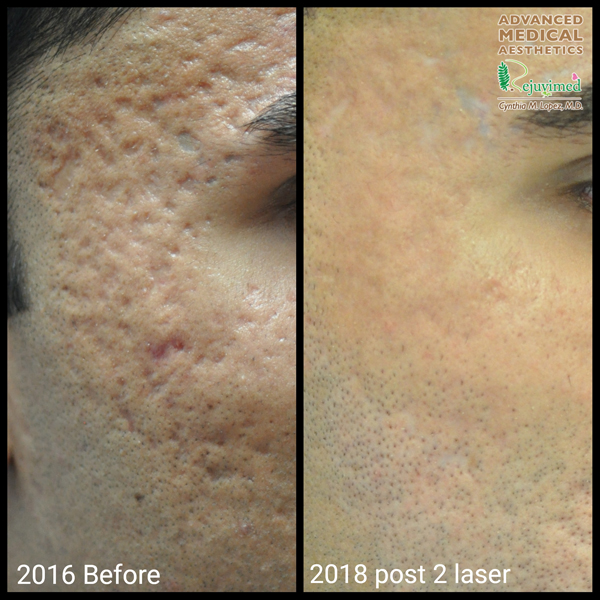Acne scars

“I used to think these scars would fade away… that time would heal them. But reality has a different plan.” – this is what most patients tell me. Many people believed in the promise that the scars of their youth would eventually disappear. It’s frustrating, but let’s talk about the science behind these scars, in a way you can visualize and understand. The more you know, the less you blame yourself and the more you understand why some treatments work and some don’t.
During acne infection, acne bacteria invade and wage war beneath the surface. We see cells struggling, collagen breaking down, and the aftermath of this battle etched on the skin’s surface. Acne isn’t just a fleeting blemish. It’s a battle that leaves scars – both seen and unseen.
The scars that acne infection leaves can be hollowed-out craters or raised bumps – telltale signs of the skin’s struggle to rebuild itself.
Hollowed out scars represent missing skin. These are called atrophic scars. Atrophic scars are pitted or indented scars that occur when your skin heals below the normal layer of skin due to a lack of regenerative tissue. Think of a pothole in the road that isn’t filled all the way up—that’s what the imbalanced skin of an atrophic scar is like.
Raised bumps represent excess skin. These are called hypertrophic scars. They are raised, firm scars formed from excess abnormal collagen production during healing.
Our skin fights hard against acne infection. When it’s fighting really hard, hypertrophic scars occur, determined to heal at any cost, plugging the skin defect more than it should. When the skin loses steam in the fight, the repair is lacking, leaving hollowed out scars.
If your skin can fight this hard, so can you. There are so many advanced treatments available now to smoothen the skin. But you need to be realistic in your expectations. It takes time to grind down the mountains (hypertrophic scars) and to fill up the valleys (atrophic scars).
COMBINATION TREATMENT OF ACNE SCARS
Most acne scarred skin has varying shapes with varying degrees of tissue loss. The types of scars present whether ice pick scars, box car scars or rolling scars, will require different treatment approaches because no one treatment can address the multiple problems of acne scarring. These are varying degrees of skin loss, tethering, rough skin surface and “sink holes”. Equally important is the ability of the scarred skin to heal. A scarred skin is a barren skin. In order for the treatment to be successful, the skin needs to be fertilized, so to speak. Otherwise, the skin may not be able to heal well during the recovery process from treatment. How do you fill a “pothole” in the skin? How do you loosen up the scars that are tethered to the deeper layer? How do you sand down the roughs.
To effectively treat them, a combination of approaches that complement one another, is often necessary:
1. TCA CROSS
which stands for trichloroacetic chemical reconstruction of scarred skin is very useful for very deep wide-mouth ice pick scars. A strong enough acid concentration is dabbed into the mouth of the ice pick scars – this instantly collapses the walls of these scars – where the goal is to make the scars depth shallower.
2. Subcision
is a lifting procedure that attempts to draw the base of a deep scar upward towards the surface, making the skin less wavy-looking. This procedure is a must to improve the rolling hills look of rolling scars. Subcision involves using a special tool to cut across scar bands that pull the skin inwards. Lasers don’t have the ability to release the tethering but once the tethering is released, lasers work more effectively.
3. Microtissue Coring
pulls out deeply bound scars when subcision isn't sufficient.
4. Ablative Laser Resurfacing
Resurfacing procedures remove layers of skin from the top down. Injury to the dermis by resurfacing procedures cause dermal remodeling and neocollagenesis. There are two methods of ablative laser resurfacing.
a. Full ablative method: In this method, the laser treats the whole surface area of the skin. The laser peels away multiple layers of scarred skin, similar to peeling layers off an onion. It’s a thorough and aggressive treatment.
b. Fractional ablative method: the laser removes cylindrical columns of skin. This approach involves the laser creating thousands of tiny holes in the scarred skin, leaving the skin looking like it has polka dots. The dots represent the treated areas, while the spaces in between are left untreated. This untreated skin plays a crucial role in the healing process. Because of this, the fractional ablative method tends to heal faster than the full ablative method.
When it comes to treating acne scars versus wrinkles, ablative laser resurfacing is a comprehensive but somewhat lengthy and invasive procedure. It can yield remarkable results. However, recovery from this combined procedure may take up to 14 days due to potential swelling and bruising.
In summary, full ablative mode removes layers of skin, while fractional mode drills tiny holes, with untreated skin aiding in faster healing. Both approaches have their advantages and are effective for different skin concerns, but the choice depends on the specific goals and tolerance for downtime. Fortunately, we now have the technology to dramatically reduce downtime namely stem cells, PRP, carboxytherapy, exosomes and GlacialRx.
5. Fat grafting with stem cells
uses patient’s own fat-derived stems cells to dramatically fill in deeply hollowed cheeks. This is much better than using commercial-produced dermal fillers. To top it all, fat has stem cells that can be harnessed to become new skin.
6. Platelet-rich plasma (PRP)
is a substance made from patient’s own blood. After obtaining about 2 tablespoons of blood, it is spun in a PRP centrifuge to separate the platelets from whole blood. PRP is a bit like a natural healer. When it's applied or injected into a specific area of the body, like a joint or a skin wound, it can promote healing and tissue regeneration. This is because platelets contain growth factors that stimulate cell repair and growth, speeding up the regeneration of tissues that lead to shorter recovery time.
7. Exosomes
are tiny, bubble-like structures that are naturally produced by cells in the body. Think of them as tiny packages or messengers that cells use to communicate with each other. These exosomes are filled with various molecules like proteins, genetic material, and other substances. When a cell wants to send a message or share important information with another cell, it packages this information into an exosome. Then, the exosome is released into the bloodstream or other bodily fluids, and it travels to its target cell.from whole blood. PRP is a bit like a natural healer. When it's applied or injected into a specific area of the body, like a joint or a skin wound, it can promote healing and tissue regeneration. This is because platelets contain growth factors that stimulate cell repair and growth, speeding up the regeneration of tissues that lead to shorter recovery time.
Once the exosome reaches the target cell, it can deliver its contents, which can have various effects. Exosomes are involved in many important processes in the body, such as regulating the immune system, repairing tissues, and helping cells communicate and work together. In simple terms, think of exosomes as tiny delivery vehicles that cells use to exchange important information and signals with each other to help keep the body functioning properly.
Patients with severe Grade 3 to 4 deep acne scars often require a combination of the treatments mentioned earlier. On the other hand, those with with milder Grade 1 to 2 scars have a less complex treatment path.
Grade 4 scars




The objective of acne scar treatment is typically to downgrade the severity of scars. For example, the aim might be to reduce scars from Grade 4 to Grade 3. Consequently, it's essential to understand that acne scar treatment isn't a one-time solution. Multiple sessions involving a combination of treatmens are usually necessary to achieve the desired results.
Sign Up For Our Specials
Sign Up For Newsletter and Specials.
